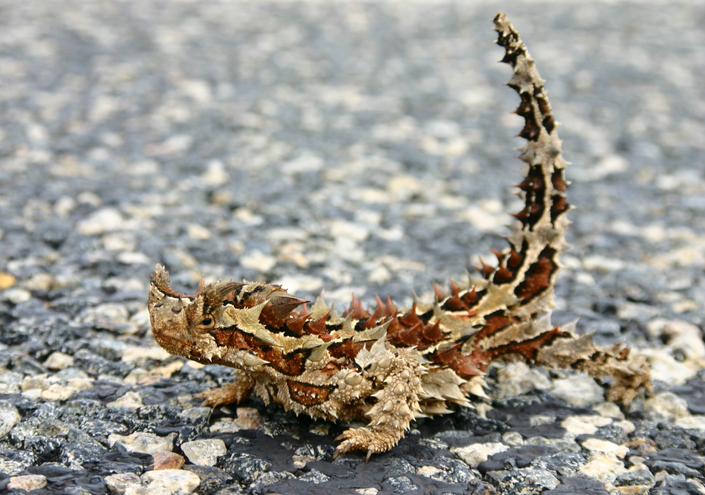Australian thorny devil
Lizard Surface Energy Wetting
The Australian thorny devil (meloch horridus) is a desert-going lizard that has developed an impressive application of transport phenomenon to make the most of a limited source of water in the arid regions it inhabits.[1] The lizard has a skin surface that contains a continuous series of micro-channels that are capable of transporting water by capillary action towards the lizard’s mouth. As the lizard crawls over and under vegetation that contains droplets of dew, it effectively collects this water all over its body, allowing it to drink on the run. The lizard’s mouth, suitable for eating ants, is not adapted to drink water directly, necessitating this curious mode of drinking.
Capillary Transport in Nature
Capillary transport is quite common in nature. It is the mechanism by which water is moved from the roots of trees up to its leaves. It is the means that our eyes drain tear fluid through the narrow tear ducts in our eyelids. This ability results from the attractive nature that water molecules have for each other, termed the forces of cohesion. This cohesion leads to surface tension, or the resistance of the surface of a liquid to an external force, such as a solid object penetrating the liquid. This tensile force causes the liquid to form a meniscus when placed in a narrow capillary, and if sufficient adhesion occurs between the water and the capillary wall, the water will be pulled along in the capillary, even overcoming the force of gravity if the capillary diameter is sufficiently small.
While this mode of drinking may appear convenient, one could argue that the quaffable benefits of the thorny devil’s capillary-driven drinking mechanical are outstripped by the social liability of its crenulated dermis. But from a surface science point of view, the thorny devil has arrived at a low energy, high efficiency method of harvesting water.
For more information on surface energy measurements, contact Cambridge Polymer Group or visit our website.
[1] Comanns et al. “Adsorption and movement of water by skin of the Australian thorny devil (Agamidae: Moloch horridus),” (2017) https://doi.org/10.1098/rsos.170591

